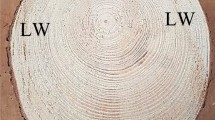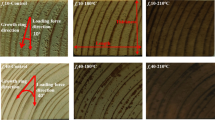Abstract
Influences of fiber orientation and milling on wood cellulose crystallinity were studied using jack pine wood. The fiber orientation effects were measured by sampling rectangular wood blocks in radial, tangential, and cross-sectional orientations. The influence of milling was studied by analyzing the unsieved and sieved milled wood fractions (all <1,000 μm). Fiber orientation effect was manifested in both X-ray and Raman measurements and was dependent upon the orientation of the sampled wood blocks. In Raman, the observed crystallinity was similar between the blocks sampled on the tangential and the radial faces. However, the estimated values were 5.5 % lower compared to that measured in a powdered sample pellet. Moreover, in these sampling modes, the orientation of the block with respect to the direction of the electric vector of the laser made a difference only for the tangential mode of sampling. When a wood block was sampled on the cross-sectional face, the observed Raman crystallinity was 3.9 % higher from that of the pellet. The observed crystallinity did not significantly differ with change in sample orientation with respect to the electric vector direction. In contrast, the Segal-WAXS study of the blocks indicated that compared to the pellet, the estimated crystallinities in the radial, tangential, and cross-sectional sampling modes were 5, 2, and 11 % lower, respectively. This suggested that the radial and the tangential faces of the blocks can be used to estimate the crystallinity of wood. With regard to the effect of milling on Raman and Segal-WAXS estimates, the wood crystallinity did not depend upon the particle sizes of the fractionated samples and was similar to that of the original unfractionated ground wood.







Similar content being viewed by others
References
Agarwal UP (1999) An overview of Raman spectroscopy as applied to lignocellulosic materials. In: Argyropoulos DS (ed) Advances in lignocellulosics characterization. TAPPI Press, Atlanta, pp 209–225
Agarwal UP, Reiner RS, Ralph SA (2010) Cellulose I crystallinity determination using FT-Raman spectroscopy: univariate and multivariate methods. Cellulose 17:721–733
Agarwal UP, Reiner RS, Ralph SA (2013a) Estimation of cellulose crystallinity of lignocelluloses using near-IR FT-Raman spectroscopy and comparison of the Raman and Segal-WAXS methods. J Agric Food Chem 61:103–113
Agarwal UP, Zhu JY, Ralph SA (2013b) Enzymatic hydrolysis of loblolly pine: effects of cellulose crystallinity and delignification. Holzforschung 67:371–377
Andersson S, Serimaa R, Paakkari T, Saranpaa P, Pesonen E (2003) Crystallinity of wood and the size of cellulose crystallites in Norway spruce (Picea abies). J Wood Sci 49:531–537
Barnette AL, Lee C, Bradley LC, Schreiner EP, Park YB, Shin H, Cosgrove DJ, Park S, Kima SH (2012) Quantification of crystalline cellulose in lignocellulosic biomass using sum frequency generation (SFG) vibration spectroscopy and comparison with other analytical methods. Carbohydr Polym 89:802–809
Bonarski J, Olek W (2011) Application of the crystalline volume fraction for characterizing the ultrastructural organization of wood. Cellulose 18:223–235
Browning BL (1967) Methods of wood chemistry, vol II. Wiley-Interscience, New York
El-Osta MJM, Wellwood RW (1972) Short-term creep as related to cell-wall crystallinity. Wood Fiber Sci 4:204–211
Fan LT, Lee Y-H, Beardmore DH (1980) Mechanism of the enzymatic hydrolysis of cellulose: effects of major structural features of cellulose on enzymatic hydrolysis. Biotechnol Bioeng 22:177–199
Hall M, Bansal P, Lee JH, Realff MJ, Bommarius AS (2010) Cellulose crystallinity—a key predictor of the enzymatic hydrolysis rate. FEBS J 277:1571–1582
Howell C, Hastrup ACS, Jara R, Larsen HF, Goodell B, Jellison J (2011) Effects of hot water extraction and fungal decay on wood crystalline cellulose structure. Cellulose 18:1179–1190
Leppänen K, Andersson S, Torkkeli M, Knaapila M, Kotelnikova N, Serimaa R (2009) Structure of cellulose and microcrystalline cellulose from various wood species, cotton and flax studied by X-ray scattering. Cellulose 16:999–1015
Murphey WK (1963) Cell-wall crystallinity as a function of tensile strain. For Prod J 13:151–155
Newman RH (1999) Estimation of the lateral dimensions of cellulose crystallites using 13C NMR signal strengths. Solid State Nucl Magn Reson 15:21–29
Newman RH (2005) Homogeneity in cellulose crystallinity between samples of Pinus radiata wood. Holzforschung 58:91–96
Newman RH, Hemmingson JA (1990) Determination of the degree of cellulose crystallinity in wood by carbon-13 nuclear magnetic resonance spectroscopy. Holzforschung 44:351–355
Park S, Baker JO, Himmel ME, Parilla PA, Johnson DK (2010) Cellulose crystallinity index: measurement technique and their impact on interpreting cellulose data. Biotechnol Biofuels 3:10
Segal L, Creely JJ, Martin AE, Conrad CM (1959) An empirical method for estimating the degree of crystallinity of native cellulose using the X-ray diffractometer. Text Res J 29:786–794
Wellwood RW, Sastry CBR, Micko MM, Paszner L (1974) On some possible specific gravity, holo- and α-cellulose, tracheid weight/length and cellulose crystallinity relationships in a 500-year-old Douglas-fir tree. Holzforschung 28:91–94
Wiley JH, Atalla RH (1987) Raman spectra of celluloses. In: Atalla RH (ed) The structures of cellulose, ACS symposium series, vol 340. ACS, Washington DC, pp 151–168
Author information
Authors and Affiliations
Corresponding author
Rights and permissions
About this article
Cite this article
Agarwal, U.P., Ralph, S.A., Reiner, R.S. et al. Impacts of fiber orientation and milling on observed crystallinity in jack pine. Wood Sci Technol 48, 1213–1227 (2014). https://doi.org/10.1007/s00226-014-0667-7
Received:
Published:
Issue Date:
DOI: https://doi.org/10.1007/s00226-014-0667-7




